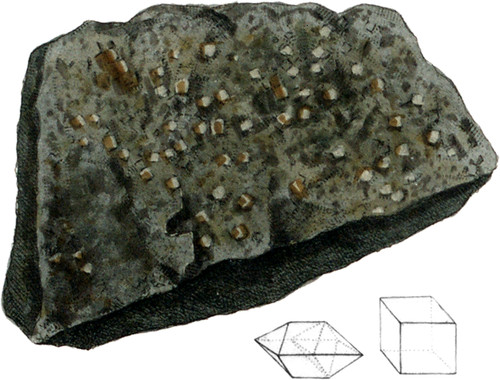 Enlarge
Enlarge
Exotic Mineralogy
Melilite
- Syn. Mèlilite. Delamétherie Thèorie de la Terre, 2, 273. Fleuriau de Bellevue Journal de Phys. 51, 455. Haüy Tabl. 64. Aikin 214.
The most complete account of this mineral is given by Fleurian de Belleme, and it seems to have been but little noticed by later mineralogists. It appears to constitute a considerable part of the mass of Lava, at Capo di Bove, near Home, and with which the streets of Rome are paved; it manifests itself in the stone by its yellow colour, and upon the surface of fissures, in crystals; the larger ones are rectangular parallellograms; they are partly imbedded, and arc often coated with an opaque lighter coloured crust; besides these, are very minute crystals, scattered almost loose over the surface, in the form of octohedrons composed of flattish pyramids joined by their rectangular bases, which are of a darker colour, but should seem to be of tin; same nature. They are accompanied by a variety of Nepheline, called Pseudonepheline, and minute crystals of magnetic Iron. Melilite is fusible, without ebullition, into a bottle green transparent glass; its powder thrown into nitric acid forms a jelly, but fragments only lose their colour, and become porous and more difficult to molt. The primitive form appears to be a rectangula prism, parallel to the sides of which it may be split with some difficulty. Fleuriau observes, that the incidence of the faces of one pyramid of the octohedron upon those of the other appears to be 115° for one set, and 70° for the other; he has also observed the primitive crystal truncated upon two or four of its edges. We are not acquainted with any analysis.

